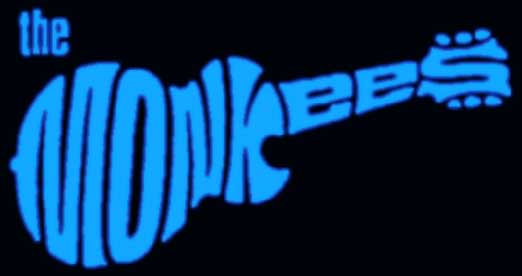
The Monkees - love 'em or hate 'em, if you hate 'em we kill your children. Simple as that. Vastly misunderstood and often dissed as a fake 60s group (despite the fact that they had more musical input than most of the classic bands of the period) and stars of a revolutionary TV series which emulated The Beatles' 'Help!' but was funnier.
1.
In a display of typical 80s kitschiness, the ITV strand Night Network started broadcasting the Monkees’ TV show in 1988. However, those familiar with the Monkees repeats on BBC children’s television in the mid-80s noticed differences in Night Network’s copies: firstly, the picture quality was far superior; and secondly, they contained scenes (and songs) which the BBC had seen fit to cut from broadcast.
A look at those mid-80s broadcasts reveals nasty, crude censorship which, given its lack of subtlety, must also have been present on the original BBC 60s transmissions (31/12/66 - 13/6/68). Anything deemed confusing to small children appeared to have been simply hacked from a celluloid reel (which perhaps accounts for the second-generation quality of the shows: possibly the BBC bought the shows a film reels rather than tapes, before making copies and cutting them).
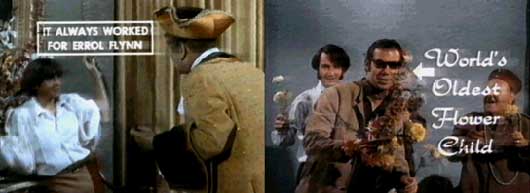
Sequences cut tended to include all on-screen captions (a regular fixture throughout the first series - a touch of sarcastic post-modernism which commented on incongruous scenes), weird cutaways (a noticeable sequence being in ‘Monkee Mayor’, which features an allusion to the first American settlers accompanied by quick shots of Peter Tork as a screaming Indian and Mike Nesmith with an arrow through his head), and - obviously - any ‘counter-cultural’ references, no matter how cagey. These sequences were chopped, no matter what scene surrounded them, resulting in sections of dialogue (and bits of songs, if they occurred mid-‘romp’) being chopped with them. The effect was like that of a badly kept reel of film with ‘joins’ every few minutes.
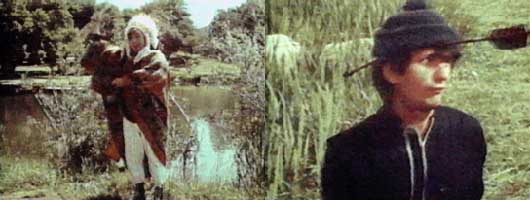
Peter Tork as a screaming Indian and Mike Nesmith speared by an arrow - a cutaway deemed unsuitable for children.
The Night Network copies were therefore a revelation to British viewers, taken from nice pristine American VT. On the downside, due to the regional nature of night-time broadcasting, the first Monkees series was mainly only broadcast in London areas, with other parts of the country joining the 24-hour ITV situation in random pockets throughout the first year or so. Night Network’s Monkees also dropped the credits, and - for odd reasons - sometimes hid the Night Network logo somewhere in the shows. They also lost their funding and ceased broadcasting halfway through airing the second series.
2.
In 1997, Channel 4 attempted to start repeating the series from scratch. At some point, things went awry and episodes were being aired as part of Channel 4’s The Bigger Breakfast (the post-9am twatfest), along with such classics as Saved By The Bell and Sister Sister. During this run, the order got a bit muddled and the Monkees On Tour show (not an actual episode, but a genuine documentary following the band’s first major tour) was omitted, presumably because the fuckshitters assumed that the viewing audience would get confused and die.
3.
Rhino home video, at the time of writing, has released ten volumes of (sadly selective) shows. The VT quality is similar to that of Night Network’s tapes, and certain shows even features the original Kellogg’s ads. A sleevenote boasts that the shows have been remastered from the original 35mm reels.
4.
Channel 4 broadcast an American documentary (Hey Hey We’re The Monkees) as part of its Monkees Weekend in 1998. This featured out-takes from the series, although their source was not disclosed. The programme also omitted pretty much all references to the film Head (1968), although a quick glance at the PRS credits at the end (‘Porpoise Song’, ‘Circle Sky’, etc) revealed that this was only true of Channel 4’s edit and that the original documentary probably had a much longer running time.
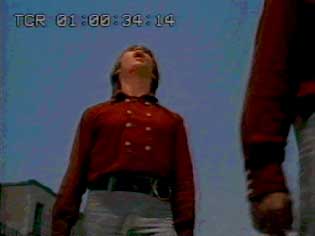
Head is The Monkees' big feature film yet few people
actually seem to know about it. Opinion tends to be divided between
the whole project being a brilliant psychedelic satire on the entire
Monkees phenomenon, and unwatchable crap. It is however the
favourite film of at least one of the SOTCAA editors and
that’s a good enough reason for us to dissect it Observations:
By the time
of the second Monkees TV series the band were getting decidedly bolshy over
the amount of creative input they had into the music and shows.
Having more or less sorted out the former worry (their third
LP, Headquarters,
was almost entirely played by themselves as a
band), the second hassle was resolved over a number of meetings. After
the second series The Monkees would release a feature film.
Initially they hoped to script it themselves but a compromise was
reached over a series of tape-recorded chat sessions about the sort
of film they’d like to make. The script was written (by Bob
Rafelson and Jack Nicholson) as a result of these chats. This wasn’t to be a cash-in teenybop affair
(the time for such films had long since passed anyway, although the
Monkees magazine still continued the gushing over Davy’s
features). The film is
‘non-linear’ (a phrase we despise but sort of fits
here). More accurately it could be described as a direct satire of the American movie industry, with
the group bouncing from scene to disparate scene with little to
connect them. The effect therefore is that they’d made a dozen
separate films, then snipped random scenes out of each and stuck
them back together. Director Bob Rafelson has said that one intention
was to make as many films as possible. For the most
part the scenes aren’t even played as comedy which, to anyone
familiar with the frivolous antics of the TV series, makes the whole
affair look decidedly creepy. Some scenes appear as fake ‘rushes’, with
cameramen and directors looming into view with clapperboards.
All this is linked with the songs – not Monkees
'classics' (as one might expect from such a cash-in) totally
new tracks. There’s no
title-caption. The film starts with a scene of a Mayor attempting to
open a new suspension bridge, going through all
the rigmarole of addressing the crowd. He has problems with microphone feedback (which
miraculously fixes itself when the Chief of Police tests it.). Finally
the PA works to his specifications and he starts to cut
the ribbon. At this point – a whole two and a half
minutes into the film – Mickey Dolenz runs through the ribbon as if winning
a race, closely followed by the other Monkees. They appear to
be running for their lives - screaming klaxons and horns announce some
sort of emergency throughout - but there doesn't appear to be anybody
actually chasing them. Micky reaches the end of the
bridge. There's nowhere else to run so he climbs onto the edge,
looks back a final time and jumps into the river. The other three look
over the side in horror and disbelief. This opening scene is often
misquoted, with reviewers claming that all of the group commit
suicide. In fact it could hardly be counted as suicide in the
first instance - more that since whatever is chasing them is so
horrible, Micky decides to take his chances in the water! As
the film later reveals the scene alludes (via a contrived yet
unnerving metaphor) to the band attempting to escape the clutches of
the very studio which has made them famous. But why does Micky
jump rather than Mike Nesmith or Peter Tork, both of whom - being
serious musicians (man) - were always far more indignant and irritated
about their 'synthesised' image than Micky Dolenz or Davy Jones
(both trained studio actors).
Micky falls
and the beautiful ‘Porpoise Song’
begins. A Goffin and King song still hailed as a
psychedelic classic. The visuals match the song note for note
with an eye-popping explosion of pre-LSD-sequence-in-Easy-Rider colours as Micky hits the water and starts to
drown. At which point two mermaids rescue him and carry
him to the surface. Mix through to Micky being
kissed by a girl near a fishtank. We are in the Monkees' pad.
Not the wacky house from the TV series but a reasonable
facsimile. The same girl then kisses Mike Nesmith, Peter Tork and
Davy Jones in turn (the latter producing a pleasing effect of
orchestras and birdsong). After all this, the girl announces that
the score is ‘even’ and leaves. This scene doesn’t
appear to allude to anything, other than perhaps exposing the
fleeting nature of fame. The Monkees present ‘Ditty
Diego’ which is a searing dismissal of their fame,
accompanied by screenshots of each of the scenes about to feature in
the film. The final screen is filled with the famous film of a
Vietcong suspect being shot through the head at point blank range. A
girl screams hysterically. Not at the war atrocity but at The
Monkees. We see a crowd of kids in an auditorium chanting 'We
want the Monkees...' The band do a war chant on a football field, mix
through via a short montage of explosions and war footage to a
battlefield. The band are in battlegear in a trench. Davy complains
that the trench is too deep. Micky offers his helmet for Davy to
stand on, complaining that he doesn’t want to wear it anyway
(‘It’s a drag, it presses down on my
head…’). Peter volunteers to get more ammo from the next
trench. As he darts across the battlefield, bombs and shells
exploding all around, a photographer appears. ‘Hold it
– this is for Life’, he announces. He see the life
cover, with appropriate fanfare. Peter looks heroic on the cover which obviously
doesn’t show the truth of the war. He reaches the trench and is suddenly confronted
with an American football player who charges at him repeatedly,
using the confused bass player as a practise partner or something.
Peter leaves immediately, much to the chagrin of ‘Number
One’ who is dismayed at the loss of someone to play with. He
throws his football helmet at Peter who later gives it to Micky to
replace his army issue headgear. The Monkees go over the top and run toward a cave.
But when they emerge they are no longer in army uniform – in
fact they’re running towards a stage where the screaming girls
await them. They play a song called ‘Circle Sky’, a
damning protest against war. The screaming girls are intercut with more
scenes of war atrocities, again blurring the line between what they’re
actually screaming about. Micky’s drumkit has the
word ‘Drum’ written on it which, with the constant overlay
effects of mirror images sometimes appears backwards as ‘Murd’,
perhaps short for ‘murder’ (a la
The Shining
– a
film which was to feature Jack
Nicholson). The song is performed live and is possibly there as
proof that the band could play their own instruments – and
they bloody do too. ‘Circle Sky’ stands as one of
rock’s
greatest live performances. A special free gig was arranged for the
filming during which the song was played several times along with
others from their repertoire. A second gig was also arranged to
accommodate the vast response from the fans who wanted tickets. At the close of the song the audience rush the
stage and tear the band to pieces, or at least plastic dummy
replicas of them. A comment on plastic, manufactured pop –
showing that even singing about serious issues doesn’t stop
the audience from viewing them as disposable icons. The scene changes with a
click. Somebody is channel-hopping through TV channels. We get
a series of quick shots of black and white films, news
bulletins, commercials. We don’t yet see who is clicking
the remote control however. The final scene on the TV screen
is Micky Dolenz, wandering through a desert. Mix through to the actual
film. He is thirsty and desperate.
His voiceover announces ‘My canteen is empty, for once it
was full…’.
His willpower and drive leads him to continue to
reach his goal however – the goal revealed as a large Coca Cola
vending machine. Unfortunately the machine is empty and he loses his
temper, kicking the shit out of it to the strains of a merry Coke
jingle. A tank appears on the horizon. A man jumps out and,
after ensuring that Micky is American, hands him a gun and insists
on surrendering to him. He leads a large group of soldiers off over
the opposite hillside. Micky gets into the tank, points the shooter
towards the vending machine and blows it to bits. Cut to all four Monkees in a
harem, relaxing, smoking hookahs and being entertained by
provocative dancing girls to the strains of ‘Can You
Dig It’
. Cut to a cowboys and indians film. Testy True (a
young Terri Garr) is asking a cowboy (Micky) to suck some venom out
of a snakebite on her finger. Mike is also wounded and requests help
in pulling an arrow out of him. Davy and Peter meanwhile have been
sent for reinforcements (a quick cutaway shows the two at the
harem). While Garr’s acting is melodramatic, the two Monkees
seem to be plodding through their lines irritably. Garr faints from
her wound but Micky kicks her awake, announcing ‘Come on,
lady, wake up, you’re not dead!’. He then loses it,
announcing that he doesn’t want to do it anymore (he is
immediately shot by two arrows which he just brushes away,
denouncing their fake-ness). He walks off the set, ripping through
the background scene, closely followed by a faintly surprised
Mike. Cut to a street front. Davy is entertaining
admiring neighbours with a violin recital. Micky and Mike walk
straight into the scene and lead him away from it while the violin
backing sticks. Tim Carey (as ‘Lord High
& Low’) appears. He is a melodramatic actor type with a
cape. He tells the group that he’s been ‘looking all
over the world’
for them, before announcing that he wants to exploit them with
by-products and spin-offs (‘the whole phallic thing is
happening’). The
group walk off, disgusted. Tim Carey was a renowned character actor
and also the star of The World’s Greatest
Sinner
, a film scored by Frank Zappa
(who has a cameo in Head). A series of smoke signals, morse code bleeps and
whatnot alerts several people on the studio set that The Monkees are
heading for the canteen. ‘They’re coming,
they’re coming…’, warns a lookout. At this
point the entire canteen empties in disgust. ‘I can’t
eat with these stinking kids around’, growls one such
deserter. This is based on the group’s experiences in the
studios when they started making the TV shows – with their
long hair and everything, nobody wanted to eat with them. Also
interesting is the link with the Micky-in-the-desert scene in which
he had announced ‘My canteen is
empty…’. The canteen scene reveals Peter Tork, sitting forlornly
staring at a melting ice-cream in his hand. He is gripped with inner
turmoil as he now longer wants it but can’t throw it away
because ‘There are starving Chinese…’.
The rest of the canteen scene is a masterwork of
densely-written wit with the waitress (drag act T.C. Jones)
continually berating the group with sarcastic digs at their
manufactured image (‘Are you still paying tribute to Ringo
Starr?’, she asks Micky). The group elegantly return
vicious barbs about the quality of the food. Eventually the group
decided to leave (aside from Peter, still gripped with remorse).
‘What about the food?’, asks the waitress.
‘Have it cleaned and burned’
, slurrs Mike. Davy however goes too far and, for
his last dig, is rewarded with a slap across the face. Cut to Davy in a boxing ring
being pummelled really badly by Sonny Liston (who’s other big
link to pop culture is appearing in waxwork form on the cover of
Sgt Pepper). In the audience Mike is
playing a shady boxing promoter, with Micky as his manic sidekick.
It would appear that the fight (somewhat unevenly matched anyway)
has been fixed in Liston’s favour. With each fall to the
canvas, Micky continually shouts ‘Stay down!’
but heroic Davy doesn’t appear
to hear. The scene is a parody of 60s
B-movies about heroic young boxers (Kid
Galahad
, etc)and features a straight performance from Annette
‘Beach Party’ Funacello who appeared as the girly
heroine in a lot of such films. Through Davy's hazy bruised
eyes, we get a flashback which shows how he got himslf into the
unfortunate position of being clobbered by an enormous boxer. A
melodramatic scene in which Funicello begs him not to do it. It
transpires that this is part of the same film which featured Davy as
a violin player (the same sacharine-drenched score playes in the
background). He insists to his girlfriend that he’ll never
make it to Carnagie Hall but he could excel at boxing .
‘They pick the round and I pick the guy’,
he announces. During the
scene, a mystery hand wipes a tear from Funicello’s sweetly
sobbing face. The link to the next scene (in which Davy is led to
a line up of potential boxing competitors) is odd. It appears to
turn into a sort of TV documentary with hand-held camerawork and out
of vision interviewing. However, watching the scene in slow motion
reveals that Davy simply walks off the living room set and straight
into the new scene. This was obviously planned as yet another
snook-cock at the fake nature of the filming process but has
seemingly been disguised through quick-cut editing. Davy chooses Sonny Liston,
announcing that ‘he looks like a nice guy and I like his
smile’ (Liston’s face is expressionless
throughout). Cut back to the violence in the ring. Micky is still
yelling ‘Stay down’. Mike calls Micky a dummy.
Micky is incensed by this and leaps into the ring himself,
flattening Davy with a single punch, then Liston, then Mike
(‘Dummy, huh?’)
and triumphantly puts
his arm around Carol Doda before punching her out too. As hoards of
policemen swarm to arrest him, proceedings are interrupted by Peter,
standing in the corner of the ring who declares.
‘I’m the dummy, Micky. I’m always the
dummy’. Micky admits that this is quite correct and
apologises to everyone for his mistake. A policeman pats him on the
shoulder in a sort of there, there way… Mix back to the canteen scene. Peter is still there
with his ice cream. ‘I’m always the
dummy…I’m always the dummy’ are his thoughts. The
waitress tells him not to worry what the others say –
‘They’re wiseguys, punks, all they wanna do is hurt
people and abuse them…’. Peter hits her very hard
in the face. We hear a voice. ‘Okay, cut it –
print it, please’. It’s Bob Rafelson the director
of the film. T.C. Jones takes off his wig. Everyone comes out of
character. Peter is worried about the last scene –
‘Hitting a girl, it’s not right – especially
the way I feel about violence and all that stuff’. The
scene actually looks remarkably realistic as a mock
behind-the-scenes sequence. Jack Nicholson is evident at one point
(as is Dennis Hopper). Peter’s pleas fall on deaf ears.
Rafelson insists that if the scene doesn’t work then
they’ll cut it (‘Yeah, well, you tell me that but it
never happens, man’). Davy reckons it looks great, as
does T.C. Jones. However, Peter’s insistence that his image
will suffer immediately comes true as he leaves the set –
everyone gives him a wide berth. He sits down, forlornly, as fake
snow, or plaster dust, falls on his head. Mix through to Peter walking through a snowy
hillside to the strains of the beautiful ‘As We Go
Along’. In this sequence each Monkee is filmed in a different
season. Peter in Winter, Davy in Summer, Mike in Spring and Micky in
Autumn (or ‘The Fall’) as they might put it. Amusingly,
the British Monkees magazine gleaned info about this scene before
the film was released and waxed lyrically about it. Ironically the
film was never released in Britain. The pastoral scenes are overtaken, at the close of
the song, by shots of increasing industrial enterprise which hampers
the tranquillity. Cut to the group being given a guided tour of a
factory. This too is based on true life experiences when visiting
different cities. Odd things appear to be going on in the factory
– workers are experiencing accidents, drinking waste from
pipes and losing their heads. Nobody notices apart from Davy but
nobody listens to his queries. ‘Pleasure – the
inevitable by-product of our civilisation’, lectures the
factory owner, ‘The tragedy of your times, my young friends,
is that you may get exactly what you want!’. This last was
once sampled on a Carter USM track. The factory owner leads the innocent band into a
doorway, and then slams it behind them. They are stuck in darkness.
A voice – Rafelson again – asks them to walk forward and
treats them as auditionees. He requests for them to get into an
enormous mass of hair, telling them ‘Look fellahs,
you’re supposed to be dandruff, will you move it
please?’. The band comply, jumping about within the giant wig
to a jingle for a dandruff treatment. Pull back to reveal they were actually on the head
of Victor Mature. An assistant with a vacuum cleaner sucks the
miniature Monkees off his head and they disappear up the pipe,
emerging into the inside surrounded by oversized drawing pins,
buttons and cigarette ends. ‘This is not one of your standard
brands’, jokes Mike, giving it a sniff. They notice that Davy
isn’t present, being stuck up the tube. The cleaner is switched off and Davy falls out of
the other end, once again surrounded by darkness. He is
disorientated and confused, but suddenly breaks into a song and
dance routine – ‘Daddy’s Song’. This jumps
back and forth from two sessions – one with Davy dressed in
white against a black background and one with his dressed in black
against a white background (although the negative has rendered it
yellow for the most part). His dancing partner in the scene is Toni
Basil who choreographed all of Head’s dance sequences and who
later went on to have a hit single with ‘O Mikki’ which
is apparently not about Micky Dolenz. His big dance number finished, Davy emerges from
the blackness to applause. The doors of a large lock-up open and he
steps out. A ‘Critic’ (Frank Zappa) is leading a bull
along. ‘The song was pretty white’, he tells Davy and
gives him advice on how he should spend more time concentrating more
on his music because ‘the youth of America depends on you
to show the way…’. The bull meanwhile announces,
with suitably animated cartoon mouth, that ‘Monkees is the
craziest people!’. Frank Zappa’s role here
is ambiguous to say the least. As a purist, one would have expected
during the 60s that he would hate the Monkees and their supposed
manufacture. Instead he championed them, suggesting that at least
there was no insidious nature to their manufacture (unlike a lot of
the supposed ‘serious’ groups of the time). Describing
Davy’s song and dance as ‘pretty white’
is more of a Zappa phrase
(purist rhythm and blues fans of the late 50s despised ‘white’
imitators) and the rest of the dialogue isn’t
too removed from his views either. But the fact that, as a
critic, he’s treating Davy like a serious contender (while the
bull – for which read ‘critical bull’? – simply
announces a twee media-like appraisal of nothing) is probably more the
point. Zappa walks off and Davy asks some nearby G.I.s if
they’ve seen the others. These are the same soldiers which the
Mayor inspected at the start of the film. Here, for now, they are
sitting around as extras. Nearby a large black box emerges from the
ground, watched with interest by a cop. The top opens up and Mike,
Micky and Peter emerge. ‘Hey, why have we
stopped?’, asks Micky, suggesting that, following their adventures
in the vacuum cleaner, they may have worked out a way of driving
the box as a means of transport. The cop interrogates the
three, asking what they were doing in the black box. They try to
explain that ‘first, we were in a factory…’
and appear to start
questioning the non-linear storyline themselves at this point.
The cop refuses to listen to their story but they are saved from
arrest by the sudden arrival, through the miracles of quick-cut editing
by the troop of G.I.s doing a marvellous choreographed display. With
their arrival, the group are reunited with Davy Jones. The cop
meanwhile is caught up with the marching off of the soldiers. Davy visits the bathroom,
muttering to himself that the others are ‘crazy’
but assuring himself that
‘they’d better not mess with me’, with
a bit of
shadow-boxing (a back-reference to the fictionalised boxing scene earlier). He opens the cabinet in the bathroom and is confronted by a large
eye, staring at him. Davy is scared shitless and slams it shut.
Peter Tork enters, whistling ‘Strawberry Fields
Forever’ to himself and moaning about police brutality.
Davy, almost speechless with fear, points towards the cabinet. Peter
checks it but there’s nothing there. Assuming it’s some
sort of joke on Davy’s part, he leaves the bathroom, pointing
out (with a flashing graphic strobing throughout) that
‘nobody ever lends money to a man with a sense of
humour’. Is this an in-joke? A song called
'Zilch' on the Pisces Aquarious Capricorn And
Jones LP features the group repeating nonsensical
utterings picked up during tours. Is the 'nobody ever
lends money...' another such example? Davy checks the cabinet again. Still nothing there.
However as he closes it, his reflection in the mirror shows he is no
long in the toilet. He spins around. He is no longer there, but in a
dungeon surrounded by darkness, skeletons and scary mocking
laughter. We don’t know who this laughter belongs to. Davy
heads towards a glowing door, opens it wide and recoils at something
horrific. We see a close-up of an insect, but this
isn’t Davy’s POV – it’s Micky’s.
Dressed in an explorers uniform, examining the insect under a
magnifying glass, he exclaims ‘The Lancashire Midget
Greeny!’ before recoiling himself, and skidding (with an
inappropriate orchestral waltz backing) down a gravelly slope. At
the bottom, two Zulu warriors seize him and chain him up against a
concrete wall, next to Peter and Mike. ‘Now here’s
my plan…’, says Mike. The wall spins around. We are back in the studio toilet
– the three are still against a wall, but not chained –
they have their hands up as, once more, they’re being
interrogated by the cop. ‘Where is whatsisname – the
greeny…?,' he asks (is 'Greeny' an American nickname for a Brit? It
does at least tally with the
‘Lancashire Midget
Greeny’ description – Davy Jones hails from Lancashire
and is quite short). It transpires that Davy hasn’t been seen
since he entered the toilet (or ‘The john…er,
comfort room’ as Micky describes it,
sending up American circumlocution of matters of
hygiene matters. The cop assures them that the police force will
find Davy and orders them out. Checking first that nobody
else is about, the cop dances a provocative dance towards the sink.
When he opens the cabinet he too is dismayed. Not a staring eye this
time but a very famous actor dressed in safari gear.
‘Victor Mature!’
exclaims the cop
before fainting. Victor giggles nonchalantly and creepily at this.
We see that he’s standing in the same dungeon as before and
was presumably the source of the mocking laughter from Davy’s
earlier experience in there. Victor Mature plays ‘The
Big Victor’ which is meant as a satire on the RCA Victor label
which owned The Monkees. Not quite so
big at this point in the film however. Mature is another odd choice as
a supporting player, more suited to burly heroic roles. Upon reading the script,
Mature is reported to have said ‘I don’t
understand any of it but it makes me laugh’. The cop is unconscious. A caption reads ‘The
Cop’s Dream’. Mix through to Mike waking up with a start
at the sound of a door buzzer. We are back at the Monkees’ pad. Mike walks
through to the living room and chastises Peter and Micky for not
answering the door. Davy is not present, being still missing.
Although still non-linear (this is purportedly a dream sequence but
no further allusion is made to it being a specific fantasy) it
appears to start following a logical storyline progression here. Peter answers the door. It’s a telegram,
delivered by a sniggering mailman and an underclad girl. Peter reads
the telegram and crumples it up immediately, shocked. He leaves the
house, his door slamming waking Mike up once more. Micky raises his
eyebrows innocently to Mike’s suspicious manner. Cut to Peter,
running through the dungeon from before. ‘Stop!’
shouts The Big Victor’s voice. Cut back to Mike reading the
uncrumpled telegram. ‘Stop’ is the only word on it. He
turns to Micky for some sort of explanation but Micky has now
disappeared too. Mike searches the cupboard and is startled by
Micky’s dummy (from the ‘Circle Sky’ scene)
which falls out. At this point the scene turns psychedelic and Mike
stumbles in slow motion towards the same dungeon. He approaches the
glowing door and opens it. A darkened room greets him with three
monks chanting a mournful drone lit by a spotlight. The three unmask themselves to reveal themselves to
be not monks but Monkees – it’s Davy, Peter and Micky.
They sing ‘Happy Birthday’ as crowds of Mike’s
friends emerge from their hiding places and start some furious
back-patting. A swinging party ensues to the strains of the song
‘(Long Title) Do I have To Do This All Over
Again’. A swinging psychedelic party ensues intercut with
scenes of dancers from an ancient black and white newsreel for
contrast. The song ends but Mike is far from pleased. He
party-poops angrily, declaring ‘if you want me to come to a
party, you don’t kidnap me – you send me an invitation.
Happy Birthday – hah!’ The consternation of the
party-goers turns to pantomimetic reaction as Mike says
‘The same thing goes for Christmas!’. Mike
Nesmith has always been known as the miserable git of the group and
this scene appears to play up to that. The crowd however suddenly
appears to change its tune, announcing
‘Attaboy’
. Tim Carey arrives, in cowboy garb, in a hand-pedalled
wheelchair. He stands up and announces ‘Attaboy, Mike,
attaboy’
. He
approaches them, repeating this line as a mantra while slowly
turning into a spastic. The group are initially very scared by this
but, as the spasmodic gurglings of the character grow wilder, they
end up collapsing into laughter, mocking their tormentor. A gunshot is heard. The spastic cowboy is seen,
outdoors surrounded by gunmen. No longer disabled, he slyly
announces ‘Boys, don’t never, but never, make fun of
no cripples…’ Cut to a black and white vox pop sequence of
members of the public announcing what should be done to people who
laugh at other people. The last one suggests that ‘jail’
is the only answer. Cut to the Monkees in a darkened cell. The
jury’s whispered verdict announces
‘Guilty…guilty…guilty…’ A Swami delivers a
lecture. We were speaking of belief...beliefs and
conditioning'. This is perhaps the most telling part of the
film as it appears to attempt an explanation of what's going
on. The lesson deals with perceived realities and advocates
keeping an opened mind. The mist clears slightly and we see
his one disciple, Peter Tork, wrapped in a sheet, intently devouring
his master's words of wisdom. At the close of the lecture,
The Swami announces 'But why should anyone listen to me?
Should I speak - since I know nothing' and giggles a bit.
We then see Sonny Liston sitting in the corner. '
How’s about some more steam’, he says and pulls a chain. Doh - they were in a sauna!
The room fills with steam and Peter gets lost in it all. He emerges
back onto the studio lot, searching for the others. Having received
the wisdom of the master he believes he has the answer to why things
are so weird. Micky and Mike are too busy watching an hysterical
woman atop a high building threatening suicide (and making callous
bets as to whether she’ll jump or not) to listen to Peter. He
knows where to find Davy however – back at the toilet checking
the cabinet for eyes. Davy however is in no mood to listen to Peter
either.
Davy ignores Peter’s insistence that everything is going to be fine and rejoins
Mike and Micky. Mike has won the bet – the girl jumped
(but Mike has obviously caught her). He hands the girl to a
still-protesting Peter and the other three walk off. Peter dumps the
girl into a passing prop van crate and catches up with them just in
time to see a recreation of the factory scene – the factory
owner leading them towards another black box. Too late – once
more they’re stuck. Peter has obviously gained
enough insight from the Swami to see this coming but the others are
just as confused as before. Looking to Peter for answers – a
second generation of teaching – they sit around and listen to
him delivering a similar lecture to the Swami’s, again ending
with ‘Why should I speak, since I know nothing’.
This does not go down well with Davy who expected a plan of
escapeat least. 'It doesn't matter whether we're in the box or
not’
, proclaims Peter. Davy disagrees completely and shows a
way out – by kicking the door down and battling against
the factory workers in an Errol Flynn-style choreographed fight scene. The
others soon follow suit. Having left the factory
environment they stumble onto the exterior cowboy set. Tim
Carey’s cowboy, along with some heavies, attempt to stop them
getting further but Davy shoots them down with a cannon which
appears from nowhere. 'Where'd he get the cannon?'
asks Peter. Micky returns a resigned shrug,
just going with the flow. At this point they are stopped
in their tracks by The Big Victor who suddenly appears as a giant,
looming over them. An Attack Of The 50 Foot...
scenario. He cackles again
and claps them back into the black box which a helicopter carries
through the air and unceremoniously dumps into the desert where Micky had staggered
before. The box opens and they see, standing accusingly
on the horizon around them, most of the characters from the film.
The camera tracks slowly past these - the factory workers, the
GIs, Victor Mature in his actors chair, etc, and finally alights,
ominously, on the Coca Cola vending machine. The characters charge, on horseback, towards them.
The tank makes a reappearance and chases them, firing a shell which
once again blows up the vending machine. The Big Victor swipes them out of the desert with a
golfclub. They land back in the studio, Peter onto Frank
Zappa’s bull which strays into the canteen which causes the
inhabitants to empty once again (and the waitress, still out of
character, to get annoyed). The group are strapped to a treadmill which heads
towards some rotating knives. The film suddenly turns into an old
black and white slapstick comedy. They attempt to drive out of
the studio in a beach buggy. Tim Carey’s cowboy (alive now) attempts to stop them again but fails.
The slapstick continues with silly sight gags. The buggy rips through
another paper backdrop and they’re back in the desert, The Big
Victor attempting to crush them underfoot. Pull out to reveal
this fantastic scene occuring on a TV set. Victor Mature, apparently
out of character, is watching all this in the comfort
of his living room. We realise that Mature is the channel hopper of previous
scenes. He yawns at the drama unfolding in the film and
eventually kicks the TV screen (which causes the group to fall out
of their buggy and The Big Victor to hurt his foot). The Monkees run like mad as everybody from the film
pursues them. We hear the voice of the Mayor who made the
speech. Full circle, the group once again interrupts the
opening of the bridge by speeding through the tape, this time
pursued by all the film’s characters. As the
Ditty promised, 'And when you see the
end in sight the beginning may arrive'. This time however
all The Monkees jump. We hear ‘The Porpoise
Song’ again.
No mermaids, just the group spiralling around in the
depths of the waters. They attempt to reach the surface but are
stopped by some invisible force. Pull back to reveal that they are
in a large fishtank-like packing crate on a van. The van drives
off with The Big Victor sitting smugly on the back. The Monkees are trapped,
presumably to be filed away until future notice. The studio has
won. The credits roll. The cast are as follows: ANNETTE FUNICELLO Minnie Introducing And VICTOR MATURE as The Big Victor One page of credits comes after the main production
crew and features backwards writing: SREBMAHC YRRET Oreh This last is possibly some sort of Equity thing.
John Hoffman who plays the ‘sex fiend’ may be a
mistyping of ‘John Brockman’ who is the face who smiles
briefly during one of the channel hopping scenes (and was used in
the TV ads – see below). ‘Frodis’ meanwhile
isn’t a backward word, but the final episode of the Monkees TV
series was called ‘The Frodis Caper’.
There may be some very obvious in-joke here but we’ve not seen
the episode in question so we can’t elucidate further. Ads for Head were
minimalist and confusing – two radio spots were prepared, each
boasting a sound-collage of music and dialogue with dismembered
voices droning ‘Coming…sooon…’
or ‘Now…playyingg’ over the top.
Legend would have it that the only actual TV ad featured a shot of a
greasy man’s face, practically motionless for thirty seconds,
then smiling slightly at the end with the film title appearing near
his head. The ‘Hey Hey We’re The
Monkees’ C4 documentary showed a brief clip of a
flashing head logo which was presumably part of a more substantial
trailer but the doc omitted any further mention of the film. As we
mentioned, we reckon the documentary was much longer originally and
presumably the British edit assumed the Head
references were discardable. The film was actually not released in Britain at
the time (despite the British Monkees magazine including several
preview articles and production photos). Only in 1977 did it play to
British audiences when the National Film Theatre ran a special
screening. Everyone assumes that the reason for it dying,
aside from the minimal publicity, was the lack of a viable audience
(teenybopper Monkees fans would hate it because it didn’t make
sense, hippies or freaks would hate it because it featured The
Monkees). The revolt against the group had reached fever-pitch by
then. In a week when Yellow Submarine had also just
been released, one review of Head
sneered ‘Two Beatles films opened this week – one of
them stars the Monkees’. Received opinion obviously
stopped them from commenting on the content of the film.
Little changes down the line. The soundtrack LP also sank without trace. This
featured all the songs and these were padded out with snippets of
seemingly random dialogue and bits of orchestral score. The
‘Album co-ordinator’ was Jack Nicholson. ‘As We Go Along’, also the B-side of the original
‘Porpoise Song’
single is a different
mix to the film version and the vocals are slightly lower down in
the mix. ‘Daddy’s Song’ also differs as the final verse is sung in the same
jaunty way as the rest of the song, whereas on the film it’s
sung in a downbeat manner with a tinkly orchestral backing. The dialogue bits are scrappily-edited in places
but are stereophonically interesting. In most instances this amounts
to little more than Jack Nicholson pissing about with the panning,
but some instances of purer stereo occur too (as is the case with a
snippet of dialogue from the canteen scene which features
Davy’s chat in one speaker and the background music which
accompanies it in the other). Original copies are rare as fuck (we’ve never
seen one) but bootleg copies changed hands for a bit. When the
Monkees back catalogue was first released on CD in 1987 by Rhino,
the Head OST was ignored. Lightning records eventually
released in 1993 in America. The cover was slightly changed (it was
white) but was pretty much as per the original LP. Rhino's second Monkees reissue programme in the 90s
included the LP and, along with all the other LPs, made the point of
including extra tracks. These included the two radio promo
spots, a few alternate versions of tracks, some sessions-chat and
the shit-kicking live version of ‘Circle
Sky’. The LP features a studio re-recording of
‘Circle Sky’
which had apparently infuriated
Peter Tork. In fact, two separate versions of the studio cut are
available – one with rather rubbish vocals and one with pretty
good ones. This points to the existence of two separate releases of
the LP. A cassette of the LP taped by an old schoolfriend of this
editor revealed the rubbish vocals version of the song, plus lots of
orchestral stuff (not from the film) at the end. Very odd. The film has been shown on Channel 4 several times
and has been twice released on video (still available now
incidentally). Reviews of the film in the music magazines are always
polarised. Tom Hibbert (of Q Magazine) always gives it an
affectionate nod whenever he can. The negative critics however
always play on the ersatz-Beatles crap and their reviews always
betray the obvious fact that they’ve not even bothered
watching the film. This is a shame as, for sheer inventiveness
alone, Head pisses all over Help!. There was a documentary on
earlier about the band Supergrass. It mentioned that they
turned down the chance to be 'the new Monkees' offered by Steven
Spielberg. Some music journo quoted 'Ditty
Diego', adding that the dismissal of manufactured music was
very similar to Supergrass' song 'In It For The
Money'
. We however were too buy frowning at the
fact that they'd blatently nicked the title of said song from Frank
Zappa to ponder further. The band are now totally split over the merits of
Head. Mike Nesmith has gone on record as saying it is
the project of which he’s the most proud. Micky Dolenz also
defends it as great. Davy Jones doesn’t claim to actually
understand what it meant but has said it contains some
‘magical moments’. Peter Tork meanwhile is often
terribly bitter about the way it killed his free ride and seems to
diss the film wherever possible. When the group reformed as a trio
in the late 80s they appeared on TV AM. Interviewer Richard Keys had
done minimal research ‘Now let me get this straight, you
were put together as a group…to make…comedy
shows?’ (cue the band bursting out laughing), and some
confusion arose as to whether they made films or TV programmes.
‘Well, if you’re talking about our actual film, which
died a death…and probably deserved to!’ exclaimed
Peter Tork. Dolenz disagreed meekly with this but obviously
didn’t want to get drawn on it. Production photos and quotes from this article were
gleaned from Glenn A. Baker’s book
Monkeemania which includes a pretty good chapter
on the film. If anybody out there can offer anything more -
info, cuttings, opinions, etc - we'll
be ever so pleased.
HEAD
A
Monkees Movie
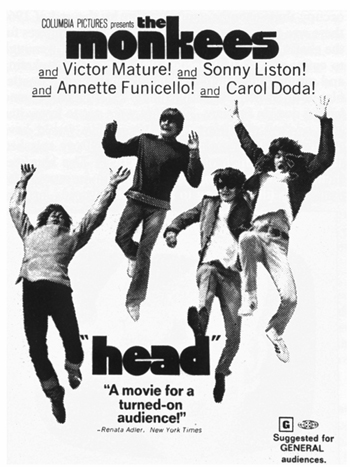


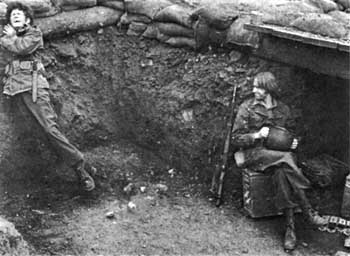
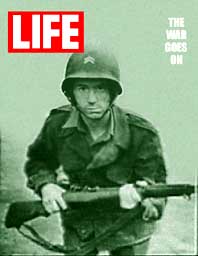
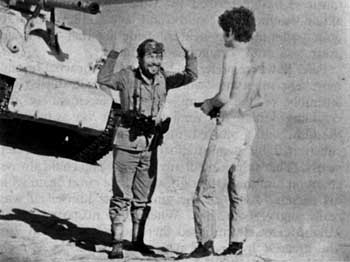

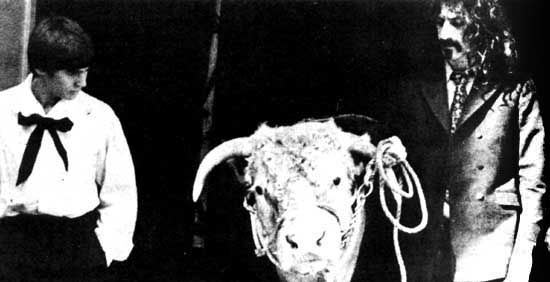

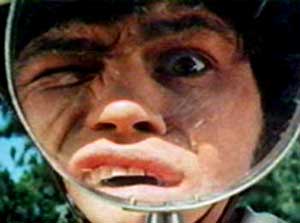

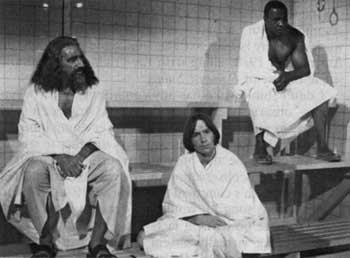
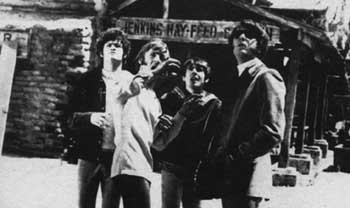
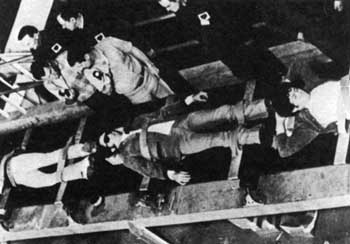
TIMOTHY CAREY Lord High
‘n Low
LOGAN RAMSEY Off. Faye Lapid
ABRAHAM SOFAER
Swami
VITO SCOTTI I. Vittefoni
CHARLES MACAULAY Inspector
Shrink
T.C. JONES Mr. and Mrs. Ace
CHARLES IRVING Mayor
Feedback
WILLIAM BAGDAD Black Sheik
PERCY HELTON Heraldic
Messenger
SONNY LISTON Extra
RAY NITSCHKE
Private One
CAROL DODA Sally Silicone
FRANK ZAPPA The
Critic
JUNE FAIRCHILD The Jumper
TERRY GARR Testy True
I.
J. JEFFERSON Lady Pleasure
SNURB EKIM
Gnihton
DRAPEHS REHTSE Rehtom
INSOTSLEH ENITSIRK Dneirf
Lrig
NANFFOH NHOJ Dneifxes Eht
REVAEW ADNIL Yratarces
Revol
YELMAH MIJ Frodis